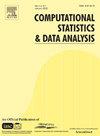Efficient Bayesian functional principal component analysis of irregularly-observed multivariate curves
IF 1.5
3区 数学
Q3 COMPUTER SCIENCE, INTERDISCIPLINARY APPLICATIONS
引用次数: 0
Abstract
The analysis of multivariate functional curves has the potential to yield important scientific discoveries in domains such as healthcare, medicine, economics and social sciences. However, it is common for real-world settings to present longitudinal data that are both irregularly and sparsely observed, which introduces important challenges for the current functional data methodology. A Bayesian hierarchical framework for multivariate functional principal component analysis is proposed, which accommodates the intricacies of such irregular observation settings by flexibly pooling information across subjects and correlated curves. The model represents common latent dynamics via shared functional principal component scores, thereby effectively borrowing strength across curves while circumventing the computationally challenging task of estimating covariance matrices. These scores also provide a parsimonious representation of the major modes of joint variation of the curves and constitute interpretable scalar summaries that can be employed in follow-up analyses. Estimation is conducted using variational inference, ensuring that accurate posterior approximation and robust uncertainty quantification are achieved. The algorithm also introduces a novel variational message passing fragment for multivariate functional principal component Gaussian likelihood that enables modularity and reuse across models. Detailed simulations assess the effectiveness of the approach in sharing information from sparse and irregularly sampled multivariate curves. The methodology is also exploited to estimate the molecular disease courses of individual patients with SARS-CoV-2 infection and characterise patient heterogeneity in recovery outcomes; this study reveals key coordinated dynamics across the immune, inflammatory and metabolic systems, which are associated with long-COVID symptoms up to one year post disease onset. The approach is implemented in the R package bayesFPCA.
对不规则多变量曲线进行高效的贝叶斯函数主成分分析
多变量函数曲线分析有可能在医疗保健、医学、经济学和社会科学等领域产生重要的科学发现。然而,现实世界中常见的纵向数据既不规则又观测稀疏,这给当前的函数数据方法带来了重大挑战。本文提出了一种用于多元函数主成分分析的贝叶斯分层框架,该框架通过灵活地汇集受试者和相关曲线的信息,来适应这种不规则观测环境的复杂性。该模型通过共享的功能主成分得分来表示共同的潜在动态,从而有效地借用曲线间的力量,同时避免了估计协方差矩阵这一具有计算挑战性的任务。这些分数还提供了曲线联合变化主要模式的简明表述,并构成了可在后续分析中使用的可解释的标量总结。使用变异推理进行估计,确保实现精确的后验近似和稳健的不确定性量化。该算法还为多元函数主成分高斯似然引入了一个新颖的变分信息传递片段,实现了模块化和跨模型重用。详细的模拟评估了该方法在共享稀疏和不规则采样多元曲线信息方面的有效性。这项研究揭示了免疫、炎症和新陈代谢系统的关键协调动态,这些系统与发病后一年内的长COVID症状有关。该方法在 R 软件包 bayesFPCA 中实现。
本文章由计算机程序翻译,如有差异,请以英文原文为准。
求助全文
约1分钟内获得全文
求助全文
来源期刊

Computational Statistics & Data Analysis
数学-计算机:跨学科应用
CiteScore
3.70
自引率
5.60%
发文量
167
审稿时长
60 days
期刊介绍:
Computational Statistics and Data Analysis (CSDA), an Official Publication of the network Computational and Methodological Statistics (CMStatistics) and of the International Association for Statistical Computing (IASC), is an international journal dedicated to the dissemination of methodological research and applications in the areas of computational statistics and data analysis. The journal consists of four refereed sections which are divided into the following subject areas:
I) Computational Statistics - Manuscripts dealing with: 1) the explicit impact of computers on statistical methodology (e.g., Bayesian computing, bioinformatics,computer graphics, computer intensive inferential methods, data exploration, data mining, expert systems, heuristics, knowledge based systems, machine learning, neural networks, numerical and optimization methods, parallel computing, statistical databases, statistical systems), and 2) the development, evaluation and validation of statistical software and algorithms. Software and algorithms can be submitted with manuscripts and will be stored together with the online article.
II) Statistical Methodology for Data Analysis - Manuscripts dealing with novel and original data analytical strategies and methodologies applied in biostatistics (design and analytic methods for clinical trials, epidemiological studies, statistical genetics, or genetic/environmental interactions), chemometrics, classification, data exploration, density estimation, design of experiments, environmetrics, education, image analysis, marketing, model free data exploration, pattern recognition, psychometrics, statistical physics, image processing, robust procedures.
[...]
III) Special Applications - [...]
IV) Annals of Statistical Data Science [...]
 求助内容:
求助内容: 应助结果提醒方式:
应助结果提醒方式:


